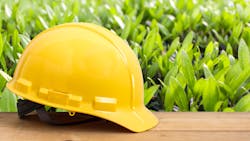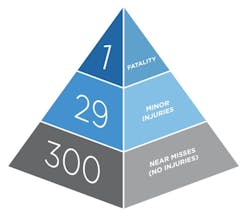You, like everyone else, have routines you follow every day. In your personal life, you wake up at a certain time, you take your coffee a certain way, you get dressed in a certain order. In your professional life, it’s not too different. You drive to work the same route, you perform your tasks similarly, and you probably don’t think too much about any of these things on a daily basis.
As arborists, however, where we work in a high risk environment, it’s important to prioritize one thing above all else: safety. Unfortunately, safety and the robotic repetition of daily tasks aren’t always necessarily compatible.
As an arborist training instructor, it’s my job to work with arborists and instill a working knowledge of safety best practices for their jobs. Lessons I hope that they’ll take with them and apply every day once they’re finished with the course. And it’s about a lot more than simply providing proper instruction and telling people how to do a job they’ve likely been doing for years.
Changing unsafe behavior isn’t a switch to be flipped; it requires determination and a lot of patience, like rigging out that monster red oak over Mr. Jones’ slate roof. Here are some techniques that I’ve found to be useful in facilitating behavior change in the classroom:
Identify the Why
Ask anyone what motivates them to get up and go to work five (or more) days per week and you’re likely to find a variety of answers. You enjoy your job. You like where you work. You like the people you work with.
But when you get down to the nitty gritty, most people will tell you they come to work every day because they need a paycheck. They need money to support their lifestyles, their hobbies, their families and loved ones, and they need a job to acquire that money. One thing I find helpful in keeping me safety-focused on the job is to keep a photo of my family with me. And I encourage others to keep one with them; in their hardhat, in their office, in their vehicle. It’s a simple tip—but it’s an effective, visual, everyday reminder to think and work safe on the job.
When it comes to changing safety behaviors, I find this motivation helpful for a few reasons. Everything you do as a part of your job can be tied back to that motivation. Why am I taking time to piece out this limb, why am I filling out this paperwork, why am I working in the rain? Because ultimately, it’s part of the job that helps you go home and support your family.
Finding this motivation, whatever it may be, is helpful in directing trainees down a path of better safety. Consider an example from the field: It’s not uncommon that arborists will go against safety protocol and touch service wires connected to homes. In fact, it’s one of the biggest behaviors I see in the field that I work to actively change. These wires typically carry up to 200 amps—far more than the 1/10 of an amp it takes to cause a fatality, and have minimum approach distances, defined within the ANSI Z133 safety standard (Avoid Contact for Qualified Line-clearance arborists and 10’ for everyone else). Would you insert a paper clip into an electrical outlet (around 20 amps) for fifteen dollars an hour? I hope not. So why would you grab the service wires for that, or any other, rate of pay? Yes, these wires have a protective coating, but why take the risk?
Consider this hypothetical conversation, which can help guide an arborist to realize what’s really at stake when contacting that wire:
Trainer: Why did you touch that wire?
Arborist: It was faster and easier to get the job done that way; otherwise, I would have needed to wait for the utility to come and drop the line.
Trainer: Why was it important to get this done so quickly?
Arborist: Well, my son has a ballgame at six o’clock…
You might see where this is going. If touching the service line in this case had resulted in a serious accident, there’s no way this arborist is making it to his son’s ballgame, or possibly any future ballgame. Using real-life examples, or narrative approaches to illustrate the risk of performing a task in an unsafe fashion, can be far more effective at changing behavior than throwing out the number of amperes carried by a service line.
But such is the challenge of changing this type of behavior: No one visualizes themselves as the accident when they’re out in the field doing the job. One practical tool to illustrate the reality of these situations, however, is the Heinrich Pyramid. This statistics-based tool was developed by industrial safety pioneer Herbert William Heinrich in 1931, which could be understood as follows: For every 300 times we make an unsafe decision and have a near miss, there are 29 minor injuries, and one accident causing a major injury or fatality.
The possibility of being that 1 in 300 is suddenly a bit clearer.
Repetition of Habits
With the “why” clearly defined, it becomes much easier to help safety trainees identify the tangible unsafe behaviors that they may be performing on the job and guides them toward change. It’s a challenge: What are you going to do out there to apply the knowledge you’ve learned in the classroom?
One of the keys to behavior change is repetition. Some of your behaviors or routines, as noted earlier in this piece, exist simply because of repetition—it’s how you perform a given, daily task every time. If you’re doing that task incorrectly or unsafely, it takes repetition in doing it properly to truly be a changed behavior.
Essential to this is repetition WITHOUT aggravation. I’ve found that behavior change is much more attainable through positive reinforcement or feedback rather than negative connotations (more on that in a minute). For example, early in my career as an arborist, I would frequently use a chainsaw one-handed, for a variety of different reasons based on convenience. Sometimes it was faster and easier to make a one-handed cut from whatever my current position in the tree may have been than to reorient myself to make the safer two-handed cut.
But one-handed cuts are unsafe, and can result in kickback incidents and other accidents that can be fatal to the operator. I was fortunate enough to have a supervisor who would kindly, yet firmly, remind me when he would observe me one-handing the chainsaw, rather than chastise me, which helped to change the behavior without discouraging me. Here repetition is key: Use your “why” to understand the importance of finding an alternative to the unsafe procedure; deploy new, safe techniques to accomplish it.
Applying these lessons is a big part of the safety training courses I run—after a classroom session, we’re out in the field doing practical, hands-on applications. It’s one thing to learn, and another to apply.
Stay Positive
Throughout my career, both as an arborist and as a safety training instructor, I’ve always found that positive feedback and reinforcement work more effectively than the negative kind. Trying to point out a change that needs to be made during practical application through positive suggestions, rather than negative feedback, is effective.
Think back to repetition without aggravation; you want these newly learned skills to be repeated in a way that doesn’t feel like a big, annoying upheaval of the way they currently do their work. They should feel like an enhancement, and that’s not possible with barking out all the ways trainees are performing actions incorrectly while training.
Overall, changing long-standing behavior in any worker is going to be a challenge. It takes overcoming habit with sound reasoning, positive encouragement and a sharp focus on the true benefit of doing things the right way: going home safe and healthy at the end of each workday.
Kevin Myers, CTSP is an ISA-certified arborist, ISA-certified Utility Specialist, Arborist Training Instructor with ACRT, Inc., and recipient of the 2016 UAA Silver Shield Award.


